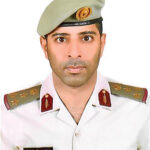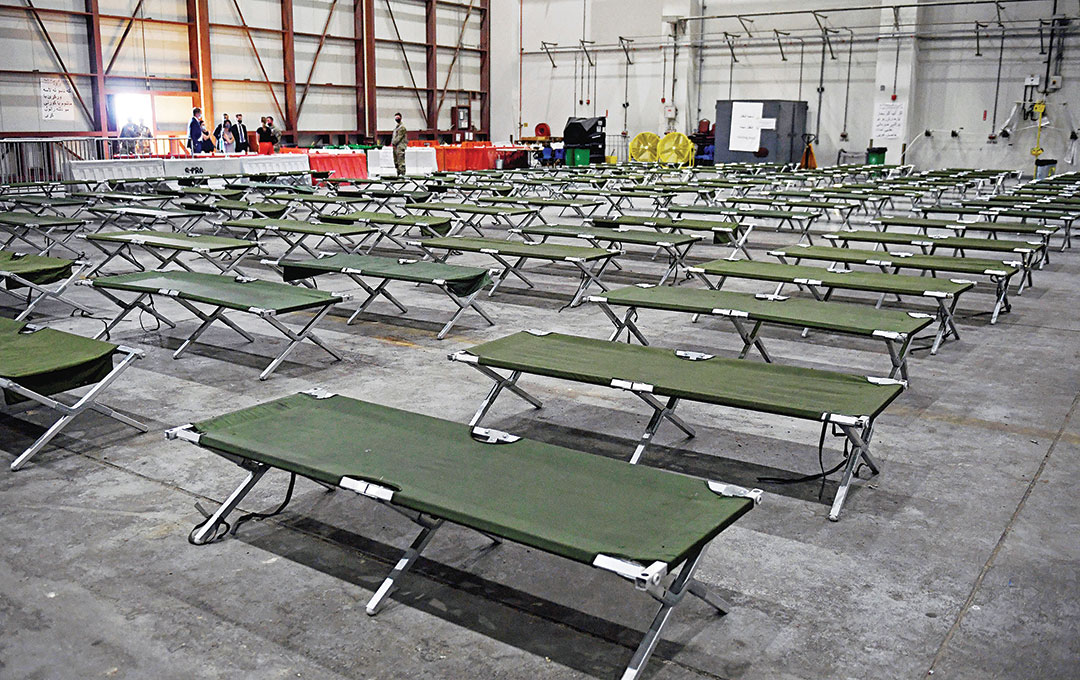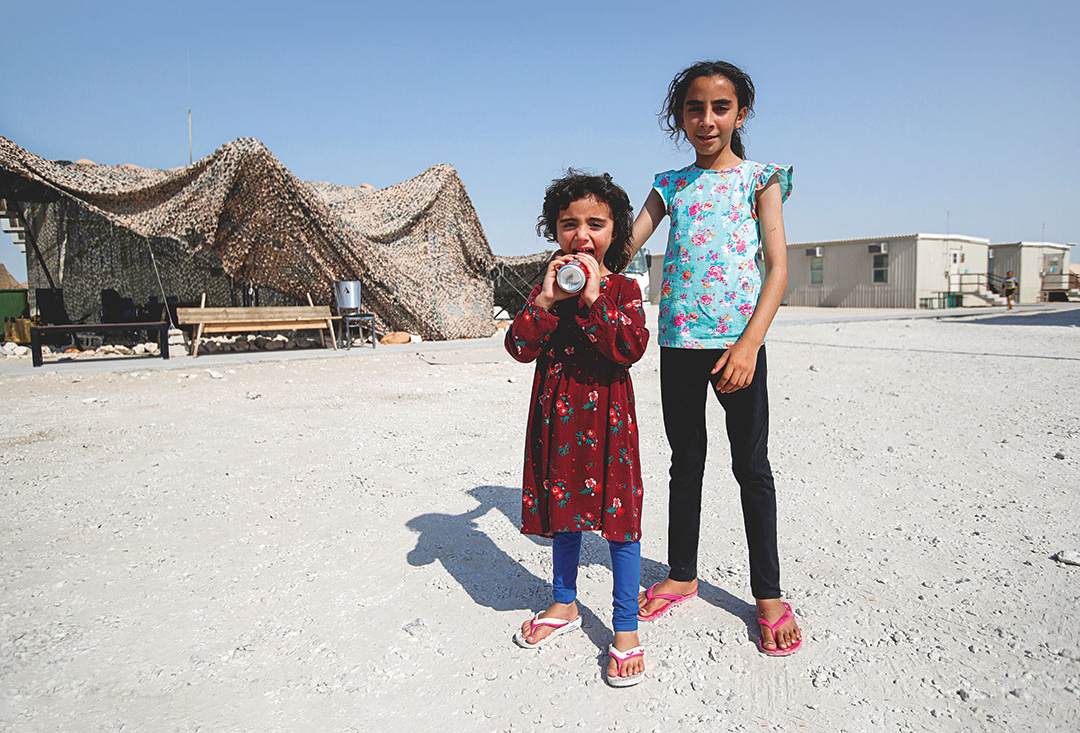Qatar Led Allied Effort to Save Tens of Thousands of Afghans

U.S. Central Command’s Unipath magazine interviewed Staff Brig. Gen. Abdulaziz Saleh Al Sulaiti, head of Qatari Armed Forces’ International Military Cooperation Authority, who is a witness to the Afghani evacuation operation and the heroic humanitarian role of Qatari leaders, based on the directions of His Highness Emir of Qatar Sheikh Tamim bin Hamad Al Thani. Qatar rapidly responded by evacuating and sheltering tens of thousands of Afghans and nationals of other countries forced to leave Afghanistan in an extremely complex security situation in August 2021.
Unipath: As a leading official in the Afghani evacuation operation, one of the largest logistic operations recently, could you explain how things started and the circumstances and arrangements of the operation?
Brig. Gen. Al Sulaiti: After coalition forces were ordered to withdraw from Afghanistan, there was a state of instability. The evacuation campaign was driven by humanitarian concerns as well as the national, regional and global role of Qatar’s political and military leaders, who are part of the international community. It was also coordinated with our strategic ally, the United States. Represented by their prudent leader, His Highness emir of Qatar Sheikh Tamim bin Hamad Al Thani, Qatari authorities responded as the Emir gave directions to provide all forms of support and assistance. This had a positive and rapid impact on carrying out the largest and fastest evacuation operation in modern history.
Unipath: How did you receive directions to start the evacuation operation?
Brig. Gen. Al Sulaiti: We received a request from U.S. Central Command through the Qatari Ministry of Foreign Affairs that a group of people was coming from Afghanistan. We took action in coordination with the ministry. Initially, the request was to evacuate Qatari nationals in Afghanistan, numbering about 8,000 people, over the course of a year. Accordingly, Al Udeid and As Sayliyah camps were prepared, and the working and transportation mechanisms were agreed upon so that all arrivals would have a barcode and a travel permit from Afghanistan. We took COVID-19-related preflight precautions. The operations were highly organized, but orders changed after people indiscriminately climbed onto American aircraft before takeoff from Afghanistan.

Unipath: How did you cooperate with Central Command and respond to its requests?
Brig. Gen. Al Sulaiti: We received direct instructions from the minister of state for defense affairs to fully support the U.S. The operation was not limited to the Armed Forces. It was a unified effort by the Qatari Ministry of Foreign Affairs, the U.S. State Department, the Qatari Armed Forces, the Qatar Fund for Development and the Qatari Ministry of Health. Al-Wakra Hospital, one of the best and largest hospitals in Qatar, was equipped to receive and treat refugee patients.
Unipath: What were the most daunting challenges in the evacuation operation?
Brig. Gen. Al Sulaiti: Transporting patients to other hospitals proved difficult; some patients were either undocumented or without identification, or were in need of amenities. The speed of events prompted challenges, but His Highness Emir of Qatar Sheikh Tamim bin Hamad Al Thani himself ordered that Al-Wakra Hospital be fully allocated to serve refugee patients.
Unipath: There were different paths for the evacuation operations. Could you explain them?
Brig. Gen. Al Sulaiti: We established four paths for evacuation operations. The first was for diplomats, which was easily accomplished because the diplomat would arrive with members of his family; some stayed in the country and others traveled farther. The second path was for journalists, students and individuals from other nations who had asked the Ministry of Foreign Affairs to evacuate certain individuals. This group of refugees was accommodated in camps prepared for them. The third path was for countries such as India and Bangladesh, which asked to evacuate their own nationals though Qatari airports onboard aircraft from those nations.
The fourth path was carried out by Central Command C-17 aircraft. This path was difficult because of the huge numbers of people and the increasing threat around the Kabul airport. What made it more challenging was that the people remaining around the airport suffered from various and intensifying health problems. We saw U.S. Soldiers carrying a number of children, helping them and lowering them over fences. It was a matter of life or death for these children because of the crowding. We did a tremendous job when they arrived, hosting them at the Qatar Orphan Care Center after they were organized based on age. We faced additional challenges in processing passports. These people were arriving in Qatar as a stopover before their final destination, and it was difficult getting them into the country. We were about to host the Arab Cup, a prelude to the World Cup. At the same time, we were surprised by the development and speed of events, especially when some nations refused or delayed hosting these people. In an effort to reduce overcrowding, the Qatar Emiri Air Force’s transport component ran several C-17 flights from Al Udeid to military bases operated by the U.S. and its allies.

Unipath: How did you coordinate the mission with Central Command?
Brig. Gen. Al Sulaiti: The initial agreement with Central Command was for 8,000 refugees over 12 months. We were surprised when 16,000 refugees arrived that first week. We had orders from the chief of staff and the defense minister to establish air-conditioned, fully equipped makeshift camps. We raced to complete these camps, being tasked to do this in three days. Over these three days, the number of refugees doubled to 30,000, then 40,000, then 50,000. Our main problem was that their arrival coincided with August, when temperatures rise, and we were keen to provide cool locations. On the other hand, all the groups had to gather in one place to complete the necessary travel requirements correctly and systematically. We even faced challenges on routine matters. For example, crowding made sanitation and other measures difficult, which led to intervention from the Ministry of Municipality. We took all necessary actions and intensified our efforts. As for food, the refugees were provided with ready-to-eat meals and we set up an operations cell within the Al Udeid Airport terminal. The cell was led by former U.S. Chargé d’affaires Ambassador Greta C. Holtz, who came specifically to head the evacuation and shelter mission. On the Qatari side were members of the Ministry of Foreign Affairs; the Armed Forces’ International Military Cooperation Authority, Logistics and Medical Services; and the Ministry of Interior, Customs, the Ministry of Health, Ambulance Services and Qatar Charity. We also set up a cell in the rear section exclusively dedicated to the Armed Forces. This cell was led by Mohammed Hamad Al-Nuaimi, head of operations. A team from the Ministry of Health began work to support this cell. As there was a high evacuation demand and limited time, we were surprised the planes were only delivering refugees, and none had been evacuated as had been agreed. The aircraft continued to transport refugees from Kabul to Qatar, multiplying the numbers. We reached a stage at which we received 900 refugees every 90 minutes until midday. The number hit 4,000 per day, and we had to provide means of transport. The airport was not equipped to receive more than 10,000 refugees over five or six hours, and it was difficult to transport this crowd. The runways were full, at times with 40 C-17 planes, in addition to planes from other countries. This required a strong team spirit and high-level coordination. Thankfully, I personally enjoyed this work alongside Lt. Gen. Gregory Guillot, commander of U.S. Air Forces Central Command, and Brig. Gen. Gerald Donohue, commander of the 379th Air Expeditionary Wing. We met at the airport, where we worked together to confront challenges and overcome obstacles. U.S. Soldiers stationed at Al Udeid spared no efforts. For every 3,000 people, there was a U.S. Army colonel appointed with all his officers, working around the clock without stopping alongside members of the Qatari Armed Forces and the Ministry of Foreign Affairs. All these efforts culminated in success. I remember one day Ambassador Holtz said foreign flights would cease and flights would be limited to arrivals from Kabul. She said that after several hours, the number would increase many times over and the preparations would not be enough. She said we would face many challenges and would have the choice to either receive the flights from Kabul or refuse them. This decision had to come from supreme command, so we informed the chief of staff. He contacted the minister and then the supreme command of the state, who decided not to withdraw and we would support our strategic ally, the United States, in receiving the refugees and providing shelter. After the approval, the number of people expected to arrive was 30,000; there were 16,000 refugees already there, so the grand total was 46,000. This number was beyond the capability of the camps, so I contacted Ambassador Essa Al-Mannai, director of the Ministry of Foreign Affairs’ American Affairs Department. We decided to provide additional Qatari aircraft to transport refugees.
I asked Ambassador Essa to submit a request to the Ministry of Foreign Affairs. I also contacted the Qatari Armed Forces Chief of Staff Lt. Gen. Ghanem bin Shaheen Al-Ghanem and provided him with details, especially about what the refugees had been through for five to seven days. They had been without shelter and food before their arrival, and the majority were exhausted during rising temperatures, which compounded the fatigue. I submitted a request to use a C-17, although we had a limited number and some had been on other missions. The chief of staff sent the request to Defense Minister Dr. Khalid bin Mohammed Al-Attiyah, who then submitted it to His Highness the Emir. An Emiri grant allocated 10 Qatari civil aircraft to transport the refugees, which was a giant step forward in alleviating the crowding. After transporting the refugees in the first 10 aircraft, we asked for and received 10 more aircraft to transport refugees. In addition, Al-Wakra Hospital was allocated to all personnel and their equipment, which cost the Armed Forces over $35 million.
This is the role of the allies in cooperating and standing up in crises, especially in humanitarian crises. We are proud of what we achieved. We have been allies of the United States for many years. In the 1990s, American forces assembled on the Qatari border and were hosted in camps, which subsequently became Al Udeid Air Base. This was, and still is, part of our preparations in support of our ally, the United States. Al Udeid is a prime example. It is a joint base between Qatari and American forces. In recent years, Qatari Armed Forces is increasingly using American weaponry. The partnership between the two nations increased the expertise of our forces, as well as the presence of U.S. forces on our base, which benefits stability in the region. We appreciate every effort made by the U.S. forces.
The development and progress of Al Udeid Air Base is in its preliminary stages. We have a plan for a comprehensive expansion of the area over several stages for both Qatari and U.S. forces (Al Udeid Air Base Development Project).

Unipath: Do you have any closing comments?
Brig. Gen. Al Sulaiti: I would like to commend the team spirit and the positive atmosphere of the evacuation operation. I must thank everyone who helped accomplish this challenging humanitarian mission. All of this would not have been possible without the support of His Highness Emir of Qatar Sheikh Tamim bin Hamad Al Thani, as well as the follow-up of His Excellency Dr. Khaled Bin Muhammad Al-Attiyah, Deputy Prime Minister and Minister of State for Defense Affairs. The operation was also under the direct guidance of then Chief of Staff Lt. Gen. Ghanem bin Shaheen Al-Ghanem, with the support and direct intervention of the Emiri Air Force, led by Lt. Gen. Salem bin Hamad Al-Nabit, the current Chief of Staff of the Qatari Armed Forces. I would like also to thank the main forces, namely the Military Police, Logistics, Operations Authority and Al Udeid Air Base. Special thanks to base commander Brigadier Youssef Shaheen Al-Ateeq, as well as the Intelligence Authority and the International Military Cooperation Authority.
With regard to non-military agencies, we cannot forget the major role of the Ministry of Foreign Affairs. Here, I would like to give special thanks to Her Excellency Lu’lu’a Al-Khater, undersecretary of the Ministry of Foreign Affairs; Essa Muhammad Al-Mannai, director of the Ministry of Foreign Affairs’ American Affairs Department; and all members of the Ministry of Foreign Affairs. Special thanks also to the Ministry of Interior, especially His Excellency Maj. Gen. Abdullah Al-Mal and all his staff. Special thanks also to the Customs Authority, the Ministry of Health, the Ministry of Municipality and everyone who contributed to the success of this humanitarian mission. Without divine providence and the support of all those people and agencies, the situation would have been a humanitarian disaster. Thank you very much! May God protect Qatar’s leadership, people and government.


Comments are closed.